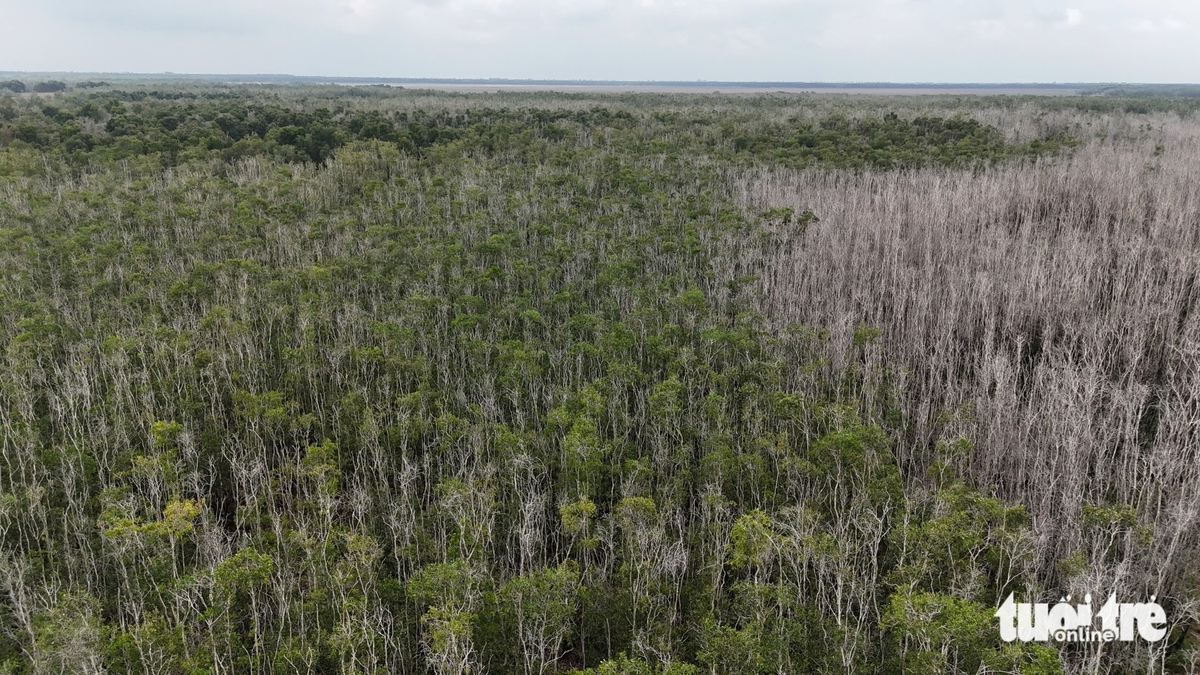In southern Vietnam, Melaleuca forest makes strong recovery nearly a year after devastating fire

The Melaleuca forest in Zone A1 of Tram Chim National Park in Dong Thap Province, southern Vietnam has recovered well nearly a year after a forest fire, with many Melaleuca trees regrowing new branches.
This recovery was observed during a field survey conducted on Monday.
In areas where the fire was most severe, young Melaleuca trees have now covered the forest floor, forming a thick carpet.
The fire occurred on June 11, 2024, in Zone A1 of Tram Chim National Park, destroying approximately 20 hectares of Melaleuca forest.
Authorities mobilized around 247 people to combat the fire, which was brought under control by 4:00 pm that same day.
The fire was caused by illegal forest intrusion and careless use of fire.
The significant recovery of the Melaleuca forest nearly a year after the fire is seen as evidence that the Melaleuca ecosystem is adapted to fire.
Melaleuca trees are moderately fire-resistant, and fire even helps stimulate seed regeneration.
Dr. Tran Triet, director of the Southeast Asian Crane Conservation Program at the International Crane Foundation, noted that the fire, with its intensity, also helped reduce the buildup of combustible materials on the forest floor, preventing larger, more destructive fires.
"Fire can be used as a tool and method for ecosystem management and restoration," Dr. Triet explained.
"For example, in January and March this year, Tram Chim National Park worked with local forestry and fire prevention forces to carry out controlled burns on nearly 100 hectares of grassland in Zone A1."
According to Dr. Triet, burning accumulated plant debris from years past helps regenerate new vegetation, providing more food for animals and making the soil more accessible.
It also removes residual debris, reducing the risk of future fires.
Tram Chim National Park has continued to coordinate controlled burning efforts in other areas of Zone A1 as part of a broader program to restore the sarus crane population.
According to scientists, the crane conservation program not only focuses on breeding and releasing sarus cranes but also on restoring the wetland ecosystem of Tram Chim, a valuable remnant of the former Dong Thap Muoi region.
Bao Anh - Tran Triet - Dang Tuyet / Tuoi Tre News
(2025/04/02-17:30)
Tuoi Tre
- 04/03 18:28 Ho Chi Minh City faces growing challenges from rapidly aging population
- 04/03 18:24 Vietnam weighs lowering tariffs on US agricultural exports
- 04/03 18:21 US president announces high tariffs on Vietnam
- 04/02 17:47 FIFA bans Vietnamese football club from registering new players over unpaid wages for foreign coach
- 04/02 17:30 In southern Vietnam, Melaleuca forest makes strong recovery nearly a year after devastating fire
- 04/02 17:07 Central Vietnam's coastal beauty enchants couple during 1,000km motorcycle trip
- 04/01 17:55 Domestic firms say not afraid of competing with SpaceX following latter's entry into Vietnam
- 04/01 17:33 Vietnamese rescuers retrieve body of 10-year-old Myanmar boy from earthquake rubble
- 04/01 17:17 Bad weather forces suspension of Ho Chi Minh City-Con Dao express boat service
- 03/31 17:42 Over 300 Ho Chi Minh City apartments report wall cracks following tremors from Myanmar quake
- 03/31 17:38 Vietnamese tourists cancel Bangkok trips following Myanmar earthquake tremors
- 03/31 11:47 Ha Long’s steamed rice rolls with squid cake offer taste of local tradition in Vietnam
- 03/31 11:33 Vietnam’s Ben Tre releases 285 million wasps to fight coconut black-headed caterpillar
- 03/31 11:28 Vietnam deploys rescue teams to Myanmar after deadly magnitude-7.7 earthquake
- 03/31 11:24 Vietnam's richest man surpasses 'Wizard of Wall Street' George Soros on Forbes billionaire list
- 03/31 11:18 Military forces in Ho Chi Minh City endure scorching heat to prepare for 50th anniversary of Vietnam’s reunification
- 03/31 11:12 Vending machines at metro stations in Ho Chi Minh City fetch over $7,800 in 2 months
- 03/31 11:10 Honda Vietnam rolls out 1st electric motorcycle
- 03/28 17:51 Vietnam air carriers plan to expand international network
- 03/28 17:35 UAE's PDSI Group eyes $2.6bn golf, service project in south-central Vietnam
- 03/28 17:22 Powerful magnitude-7.7 earthquake in Myanmar sends tremors to Hanoi, Ho Chi Minh City
- 03/28 14:11 Hanoi's ancient boat festival faces threat from river pollution
- 03/28 13:55 Helicopters, fighter jets rehearse over Ho Chi Minh City ahead of 50th Reunification Day
- 03/28 13:40 Vietnam greenlights SpaceX's Starlink satellite Internet pilot program













